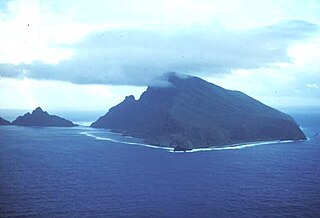
The Samoan Islands are an archipelago covering 3,030 km2 (1,170 sq mi) in the central South Pacific, forming part of Polynesia and the wider region of Oceania. Administratively, the archipelago comprises all of Samoa and most of American Samoa. The two Samoan jurisdictions are separated by 64 km (40 mi) of ocean.

Mulifanua is a village on the north-western tip of the island of Upolu, in Samoa. In the modern era, it is the capital of Aiga-i-le-Tai district. Mulifanua wharf is the main ferry terminal for inter-island vehicle and passenger travel across the Apolima Strait between Upolu and the island of Savai'i.

Fanuatapu is an uninhabited island which consists of a volcanic tuff ring, situated off the eastern tip of Upolu, Samoa. It is the smallest and easternmost of the four Aleipata Islands, with an area of 15 hectares, and has an automated lighthouse.

Tuamasaga is a district of Samoa, with a population of 83,191. The geographic area of Tuamasaga covers the central part of Upolu island.

Nu'utele is an island which consists of a volcanic tuff ring situated 1.3 km off the eastern end of Upolu island, Samoa. It is the largest of the four Aleipata Islands, at 1.08 km2.

Vavau is a small village on south east end of Upolu island in Samoa. The village is part of Lotofaga Electoral Constituency which is within the larger political district of Atua.
A'ufaga is a small village on the southeast end of Upolu island in Samoa. The village is part of the electoral constituency Lepa which is included in the larger political district of Atua.
Salamumu is a village on the south west coast of Upolu island in Samoa. The village has two settlements, Salamumu Uta and Salamumu Tai.

Afega is a village on the island of Upolu in Samoa. It is located on the central north coast of the island to the west of the capital Apia in the countryside. The population is 1,781.
Tuana'i is a small village on the central north coast of Upolu island in Samoa. It is situated to the west of Apia, the country's capital. The population is 1,247.
Siuniu is a small village on the Samoan island of Upolu. It is located inland from the southeast coast of the island.

The Aleipata Islands is a group of four uninhabited islands off the eastern end of Upolu Island, Samoa, with an aggregate area of 1.68 km²):
Poutasi is a village on the south east coast of Upolu island in Samoa. The population was 379 in the 2006 Census. The village is part of Falealili Electoral Constituency in the larger political district of Atua. Poutasi was extensively damaged by the 2009 Samoa earthquake and tsunami.
Nu'ulua, not to be confused with Nu'ulua 200 meters west of Ofu, is an island in Samoa in the Aleipata Islands situated more than 1.3 km from the eastern end of Upolu in Samoa.
Nu'usafe'e Island is a small uninhabited island in Samoa. The island is located off the south east coast of Upolu island, near the village of Poutasi.
Lotopa is a village on the island of Upolu in Samoa. It is situated on the north central side of the island near the country's capital Apia. The village is in the political district of Tuamasaga.
Matatufu is a small village on south east end of Upolu island in Samoa. The village is part of Lotofaga Electoral Constituency which is within the larger political district of Atua.
Saleapaga is a village on the south east coast of Upolu island in Samoa. The village is part of Lepa Electoral Constituency which is within the larger political district of Atua.
Malie is a village on the island of Upolu in Samoa. It is located on the north coast in the Electoral Constituency of Sagaga Le Usoga which forms part of the larger political district of Tuamasaga.









